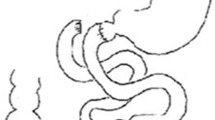Play all audios:

ABSTRACT The role of cholecystokinin (CCK) has been explored in pancreatic carcinogenesis following pancreatobiliary diversion (PBD), using the specific CCK receptor antagonist CR-1409. Male
Wistar rats (n = 80) weighing 70-100 g were given weekly i.p. injections of azaserine (30 mg kg-1 week-1) for 3 consecutive weeks. One week later animals were randomised to receive either
PBD or sham PBD and thereafter to receive s.c. injections of either saline or CR-1409 (10 mg kg-1 day-1, 5 days a week). Six months after operation surviving rats were killed as follows:
sham + saline 20, PBD + saline 19, sham + CR-1409 14, PBD + CR-1409 11. Cardiac blood was taken for CCK assay and the pancreas was excised for wet weight measurement and quantitative
estimation of atypical acinar cell foci (AACF), the precursor of carcinoma. PBD reduced median body weight (3-20% less than shams) but trebled the absolute and relative pancreatic weights (P
< 0.001). CR-1409 blunted this adaptive response to PBD, reducing absolute pancreatic weight by 35% (P < 0.005). PBD quadrupled circulating CCK concentrations, regardless of the
antagonist treatment. Acidophilic AACF occurred only in rats with PBD. CR-1409 markedly reduced the number of observed acidophilic AACF by 90% (P < 0.001) and the number of foci per
pancreas by 93% (P < 0.001). Moreover, CR-1409 reduced the mean focal diameter of each lesion by 18% (P < 0.005), the mean focal volume by 58% (P < 0.05) and the percentage of
pancreas occupied by acidophilic foci by 95% (P < 0.001). PBD enhances pancreatic carcinogenesis by causing hypercholecystokininaemia, and CR-1409 largely inhibits this enhancement.
Access through your institution Buy or subscribe This is a preview of subscription content, access via your institution ACCESS OPTIONS Access through your institution Subscribe to this
journal Receive 24 print issues and online access $259.00 per year only $10.79 per issue Learn more Buy this article * Purchase on SpringerLink * Instant access to full article PDF Buy now
Prices may be subject to local taxes which are calculated during checkout ADDITIONAL ACCESS OPTIONS: * Log in * Learn about institutional subscriptions * Read our FAQs * Contact customer
support SIMILAR CONTENT BEING VIEWED BY OTHERS HYPOGLYCEMIC MECHANISM OF INTESTINAL BYPASS SURGERY IN TYPE 2 DIABETIC RATS Article Open access 03 November 2021 CHEMICAL PANCREATECTOMY IN
NON-HUMAN PRIMATES ABLATES THE ACINI AND DUCTS AND ENHANCES BETA-CELL FUNCTION Article Open access 05 June 2023 COMPARISON OF THREE DIFFERENT ANASTOMOTIC METHODS OF SLEEVE GASTRECTOMY WITH
TRANSIT BIPARTITION USING AN OBESE RODENT MODEL Article Open access 01 December 2023 AUTHOR INFORMATION AUTHORS AND AFFILIATIONS * Department of Surgery, Royal Postgraduate Medical School,
Hammersmith Hospital, London, UK P Watanapa Authors * P Watanapa View author publications You can also search for this author inPubMed Google Scholar * B Flaks View author publications You
can also search for this author inPubMed Google Scholar * H Oztas View author publications You can also search for this author inPubMed Google Scholar * PH Deprez View author publications
You can also search for this author inPubMed Google Scholar * J Calam View author publications You can also search for this author inPubMed Google Scholar * RCN Williamson View author
publications You can also search for this author inPubMed Google Scholar RIGHTS AND PERMISSIONS Reprints and permissions ABOUT THIS ARTICLE CITE THIS ARTICLE Watanapa, P., Flaks, B., Oztas,
H. _et al._ Inhibitory effect of a cholecystokinin antagonist on pancreatic carcinogenesis after pancreatobiliary diversion. _Br J Cancer_ 67, 663–667 (1993).
https://doi.org/10.1038/bjc.1993.123 Download citation * Issue Date: 01 April 1993 * DOI: https://doi.org/10.1038/bjc.1993.123 SHARE THIS ARTICLE Anyone you share the following link with
will be able to read this content: Get shareable link Sorry, a shareable link is not currently available for this article. Copy to clipboard Provided by the Springer Nature SharedIt
content-sharing initiative
